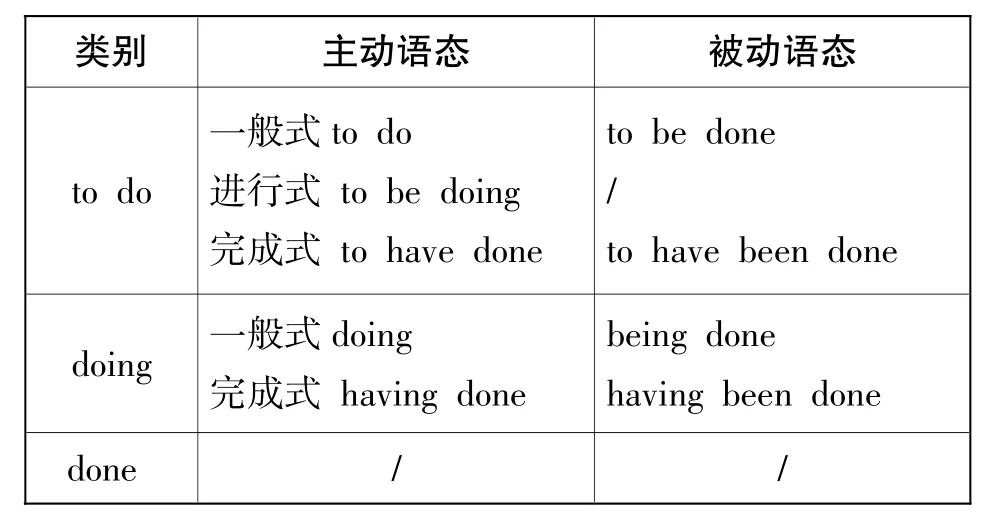非谓语动词用法归纳小结
抚顺市第一中学 周瑜
清原第二高中 王辉
非谓语动词是高中英语语法中非常重要的一部分,也是每年高考的必考内容,因此学好非谓语动词是很有必要的。非谓语动词部分知识繁杂,是高中生认为最难掌握的考点之一。要想在高考中正确答题,首先要掌握非谓语动词的功能,即不定式、分词、动名词分别在句子中作什么成分,然后掌握作同一种成分时,不定式、分词、动名词的区别。英语语法将动词的形式概括为6种:原形、单三、过去式、to do形式、doing形式和done形式。前三种可独立作谓语,被称为“谓语动词”,后三种不可独立作谓语,被称为“非谓语动词”。下面对非谓语动词形式进行总结:
非谓语动词的时态和语态构成:

类别 主动语态 被动语态t o d o t o b e d o n e/t o h a v e b e e n d o n e d o i n g 一般式d o i n g完成式 h a v i n g d o n e一般式t o d o进行式 t o b e d o i n g完成式 t o h a v e d o n e b e i n g d o n e h a v i n g b e e n d o n e d o n e / /
非谓语动词的句法功能:

成分形式主语 宾语 宾补 表语 定语 状语不定式 √ √ √ √ √ √动名词 √ √ √ √分词 √ √ √ √
一、不定式、分词作定语的区别
1.修饰序数词,最高级,no, all, any 等限定的中心词一般用不定式。例如:
She was the first woman to win the prize.
He was the best man to do the job.
2.不定式一般被动式(to be done)作定语时的动作一般发生在谓语动词的动作之后,表示 “将要”。现在分词一般被动式(being done)的动作通常和谓语动词的动作同时发生,表示“正在”。过去分词一般被动式(done)通常表示已经完成的动作,表示“已经”。例如:
The party to be held next Friday will be interesting.
The party being held now is interesting.
The party held yesterday was interesting.
二、不定式,分词作状语的区别
1.不定式主要是作目的、结果和原因状语。
To make himself heard,he had to raise his voice.(目的)
Jim went to school only to find there was nobody there.(结果)
Ⅰam sorry to hear that.(原因)
2.分词主要是作时间、原因、条件、结果、让步和伴随状语。分词作状语时,分词的逻辑主语必须和句子的主语保持一致,和句中主语含有逻辑上的主谓关系或动宾关系。
When walking in the street,Ⅰsaw my teacher.(主动)(时间)
When offered help, you should say “Thank you.”(被动)(时间)
Writing carelessly,he left out an important word.(主动)(原因)
Blamed by her teacher, Lucy was unhappy.(被动)(原因)
Working hard, you are sure to succeed.(主动)(条件)
Taken according to the directions, the drug has no side effect.(被动)(条件)
The man fell over his own feet,rolling down the slope.(主动)(结果)
Though working hard, he still failed.(主动)(让步)
Having been told many times,he still made a mistake.(被动)(让步)
He sat at the desk, thinking deeply.(主动)(伴随)
不难看出,doing形式与句中主语构成逻辑上的主谓关系,与句中谓语动词同时发生或基本上同时发生。having done形式与句中主语构成逻辑上的主谓关系,先于谓语动词发生。done形式与句中主语构成逻辑上的动宾关系。being done形式与句中主语构成逻辑上的动宾关系,且与谓语动词同时发生,一般多作原因状语置于句首。having been done形式与句中主语构成逻辑上的动宾关系,且先于谓语动词发生。
3.不定式作原因状语、结果状语和现在分词作原因状语、结果状语的区别。
当一些表示喜、怒、哀、乐的形容词作表语,后面一般跟不定式作原因状语。例如:
Ⅰam very happy to see you here.
Jim was glad to hear the news.
现在分词则没有上述用法,只表示正常的原因。例如:
Not knowing what to do,the boy went to his father for advice.
不定式作结果状语多表示出乎意料,事与愿违的结果。例如:
He hurried to the airport only to be told the star had left.
而现在分词作结果状语则表示正常的结果。例如:
An earthquake happened in Sichuan,causing many deaths.
在带有enough或too的句子里,也常用不定式作状语。例如:
He is old enough to go to school.
She was too tired to do the work.
4.有些分词或不定式短语作状语,其形式的选择不受上下文的影响,称作独立结构。有独立结构出现时,不考虑句子主语与作状语的动词的主被动关系。常见的独立结构有:generally speaking,frankly speaking, judging from/by, considering,taking...into consideration, to tell you the truth,supposing, providing, given, provided that, compared to/with等。例如:
Judging from his accent, he is from the north.
Considering your health,you should have a rest.
To tell you the truth, Ⅰdon't like him.
5.非谓语动词作状语时,它的逻辑主语应和主句主语保持一致。但有时非谓语动词带有自己的逻辑主语,在句子中作状语,被称为独立主格结构。独立主格结构的逻辑主语与句子的主语不同,它独立存在。独立主格前如果有with,这种结构被称为with的复合结构。
Ⅰt being Sunday, we didn't need to go to school.
The test finished, we began our holiday.
Weather permitting,we are going to have a picnic tomorrow.
With all the work finished,we went home happily.
With so many books to read, Ⅰhave no time to play with my friends.
三、分词、不定式作宾语补足语的区别
1.感官动词 see, watch, observe, look at, hear,listen to,notice等和使役动词have后面的宾补有下列情况:不定式作补足语强调的是一个动作的全过程,且宾语与补足语之间存在逻辑上的主动关系。-ing形式作补足语强调的是正在进行的动作,宾语与补足语之间也存在逻辑上的主动关系。过去分词作补足语强调动作完成,有时没有一定的时间性,只表示宾语与补足语之间存在逻辑上的被动关系。例如:
Ⅰsaw him blame his son just now.(主动,完成)
Ⅰsaw him blaming his son whenⅠpassed by his room.(主动,正在进行)
Ⅰwant to have my hair cut.(被动,完成或没有一定时间性)
使役动词let后加复合宾语时,当宾语与补足语在逻辑上为主动关系时,宾语补足语用动词原形;当宾语与补足语在逻辑上为被动关系时,补足语用“be+done”。 例如:
Don't let your child get up late.
Let your homework be finished immediately.
2.get, have 表示使、让、叫之意时,后接三种形式作宾补。
(1)让某人去做某事
have sb.do sth.
get sb.to do sth.
My mom had me go to the shop and buy some vinegar.
(2)have sb.doing 让某人持续做某事
get sb.doing 让某人开始行动起来
The mother had her son playing the piano for 2 hours.
The boss got his workers working after a short rest.
(3)have sth.done=get sth.done
Ⅰwill have/get my radio repaired tomorrow.
四、不定式与doing形式作宾语时的特殊搭配
有些表示主观意愿或打算的动词,后面必须跟不定式作宾语。 如:agree, ask, attempt, choose,decide, demand, determine, desire, expect, fail,happen, hope, intend, manage, offer, pretend,promise, plan, refuse, want, wish 等。
They decided to set up a team.
He failed to get the work finished on time.
有些动词的后面则必须接doing形式作宾语。如:allow, advise, appreciate, admit, avoid, ban,bear, consider, delay, deny, enjoy, escape, envy, finish, forbid, forgive, imagine, involve,keep, mind, miss, oppose, practice, permit, prevent, risk, resist, quit, suggest等。
We don't allow smoking here.
Do you mind opening the window for me?
还有下列这些特殊情况考试时要注意:
1.need, want, require 在表示“需要被”时,后面即可以接doing形式,也可以接to be done形式。
The flowers need watering.=The flowers need to be watered.
The car wants washing.=The car wants to be washed.
2.某些动词既可以接不定式,又可以接doing,但意义上有区别。 如:forget, remember, regret,mean, stop, try等。
Ⅰmean to go to the US.(打算)
Missing the busmeanswaiting foranother hour.(意味着)
Ⅰoften regret helping such a person.(后悔)
Ⅰregret to tell you that you failed the exam.(遗憾)
3.allow, permit, advise, forbid 后面可接两种形式。 即 “allow, permit, advise, forbid+for sb.to do”或 “allow, permit,advise,forbid+doing”。例如:
We don't allow playing football here.
We don't allow you to play football here.
尤其要注意被动结构。例如:
You are not allowed to play football here.
4.某些短语中的to是介词,后面需接doing形式,不要跟不定式的to混淆。常见的此类短语有:devote...to, get down to, get used to, get accustomed to, get close to, look forward to, pay attention to, object to, refer to, turn to等。
Let's get down to doing our work.
He got close to being killed yesterday.
5.还有一些高考中常见的固定句型。如:
Ⅰt is no use/good doing...
There is no sense/point (in) doing...
have trouble/difficulty/problems (in)doing...
have fun doing...
spend time (in) doing...
Ⅰt is no use discussing the matter again and again.
There is no point reading novels in class.
五、易错点清单
1.不定式作表语形容词的状语,和句中主语构成逻辑上的动宾关系时,不定式多用主动形式,这是因为句中往往在形容词后省略了for sb./sth.,不定式的主被动取决于sb./sth.例如:
The book is difficult to read.
这句话有些同学认为book和 read之前应该存在动宾关系。但其实完整的句子应该是:The book is difficult for me to read.
再比如:English is easy to learn.
The fish is nice to eat.
Ⅰt is difficult for the rubbish to be collected.
2.注意以下表达的意义区别
developing countries 发展中国家
developed countries 发达国家
a frightened expression 感到害怕的表情
a frightening expression 令人害怕的表情
3.分词的逻辑主语决定着分词的使用形式(现在分词还是过去分词),但它在句中没有固定的位置,学会找出逻辑主语在做题时是非常重要的。
作定语时,分词的逻辑主语是被修饰的词。若逻辑主语和分词是主动关系,则用现在分词;若逻辑主语和分词是被动关系,则用过去分词。例如:
Do you know the man giving the lecture now?
The novels written by Mark Twain are interesting.
作状语时,分词的逻辑主语通常是句子的主语。若逻辑主语和分词是主动关系,则用现在分词;若逻辑主语和分词是被动关系,则用过去分词。例如:
The boy sat in a chair, reading a book.
Given more help, Ⅰcould have succeeded.
若分词的逻辑主语和句子的主语不是同一个人或物,则要用从句或独立主格结构代替分词短语作状语。
正确:Ⅰt being Sunday, we didn't need to go to school.
错误:Being Sunday, we didn't need to go to school.
作宾补时,分词的逻辑主语是宾语。若宾语是宾补动作的发出者,则用现在分词;若宾语是宾补动作的承受者,则用过去分词。例如:
Ⅰfound a sign tied to a tree.
Ⅰfound a man lying in bed.


